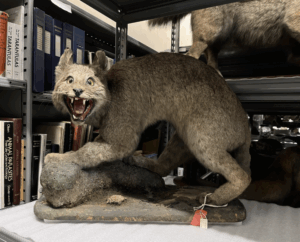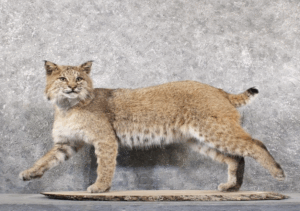BY: ANGELA LOCOCO
When you think of taxidermy in museums, what comes to mind? A snarling predator? An animal frozen in an exaggerated pose?
My journey as a Museum Studies student has reshaped how I see these specimens, and how I hope visitors will see them, too. Through my internship with Liz Scott at the Indiana State Museum, I’ve spent months working closely with the museum’s natural history and archaeology collections, specifically on the care and interpretation of taxidermy mounts. My portfolio now captures not just the hands-on techniques of grooming and preservation, but also a shift toward ethical storytelling through taxidermy.

From Trophy to Teacher
My internship centered around one big question: How do taxidermied animals in museum displays shape how people think about nature and wildlife?
Legacy taxidermy often reflected the values of the time — hunters commissioning mounts posed to emphasize “ferocity” or exoticism. These dramatized portrayals, while visually striking, can distort public understanding of animals and reinforce outdated or harmful narratives.
Today, museum professionals are rethinking this legacy. Ethical stewardship now demands that we honor the animal’s reality, using pose, care, and context to spark empathy rather than awe at human conquest.
At the Indiana State Museum, I saw firsthand how thoughtful presentation can reshape narratives. The museum’s black bear, for example, is displayed in a calm, natural stance: not roaring, not lunging. Even the mountain lion is poised in a stalking position, rooted in authentic behavior rather than spectacle. These choices matter, they shift the visitor’s experience from dominance and fear to curiosity and connection.
 Hands-On Care: Respecting What Once Lived
Hands-On Care: Respecting What Once Lived
Much of my semester was spent physically caring for mounts — cleaning a black bear, grooming a white peacock, and adjusting small details that support a more accurate portrayal. I also conducted a literature review on taxidermy ethics and had valuable conversations with Liz Scott and other museum staff about collection philosophies.
What I learned is that stewardship goes beyond preservation; it’s an act of storytelling. Every brushstroke, every adjustment to a pose, every cleaned feather is a decision about how an animal’s story is told. Through this work, I came to see taxidermy as a bridge between the living and the historical, offering visitors not just a view of the animal, but an invitation to understand it.
 Looking Forward: Stewardship as a Core Value
Looking Forward: Stewardship as a Core Value
Stewardship is about more than conserving objects: it’s about conserving meaning. When we clean and properly display a lioness or a bobcat in a calm, natural pose, we’re preserving truth over spectacle. We’re reminding visitors that these are representations of real, once-living beings: not trophies, but teachers.
This experience has deepened my commitment to ethical curation. As a graduate master’s student, I’m excited to continue working with natural history collections, advocating for practices that foster empathy, education, and respect for the natural world.
Through my portfolio, I invite you to follow this journey: one where science, storytelling, and stewardship come together to create a more ethical future for museum displays.
Full Portfolio Link: https://alococo113.wixsite.com/website
Angela LoCoco (she/her) received her MA in Museum Studies in May 2025 from Indiana University, Indianapolis.

